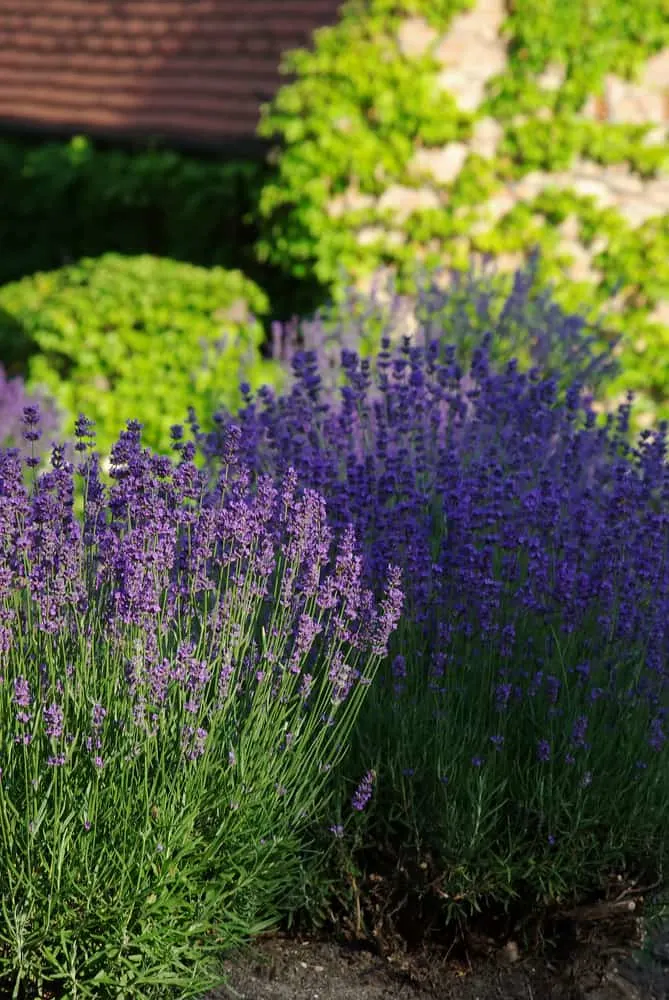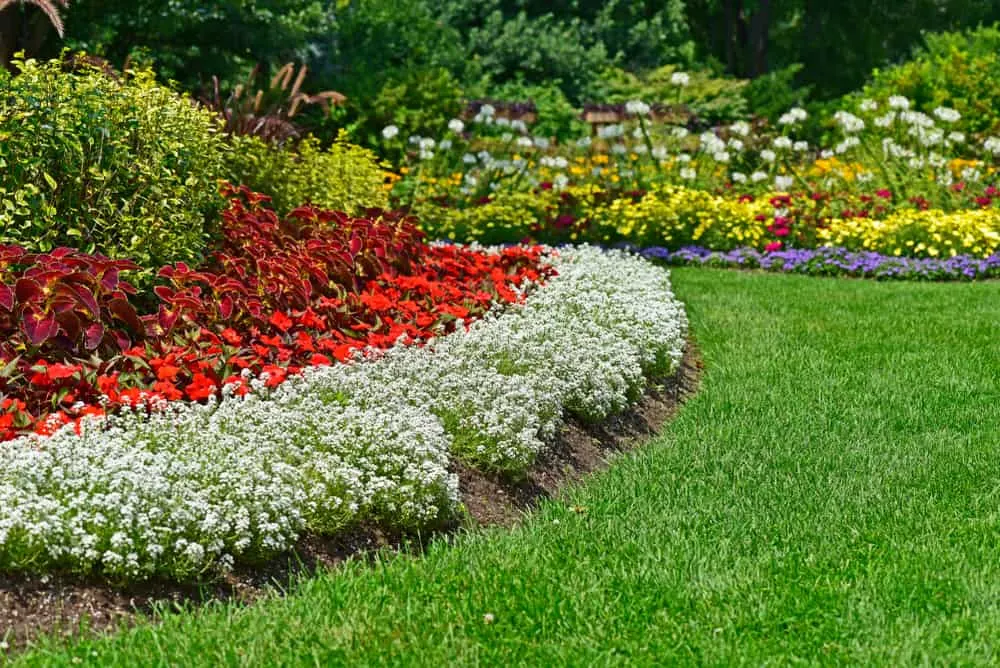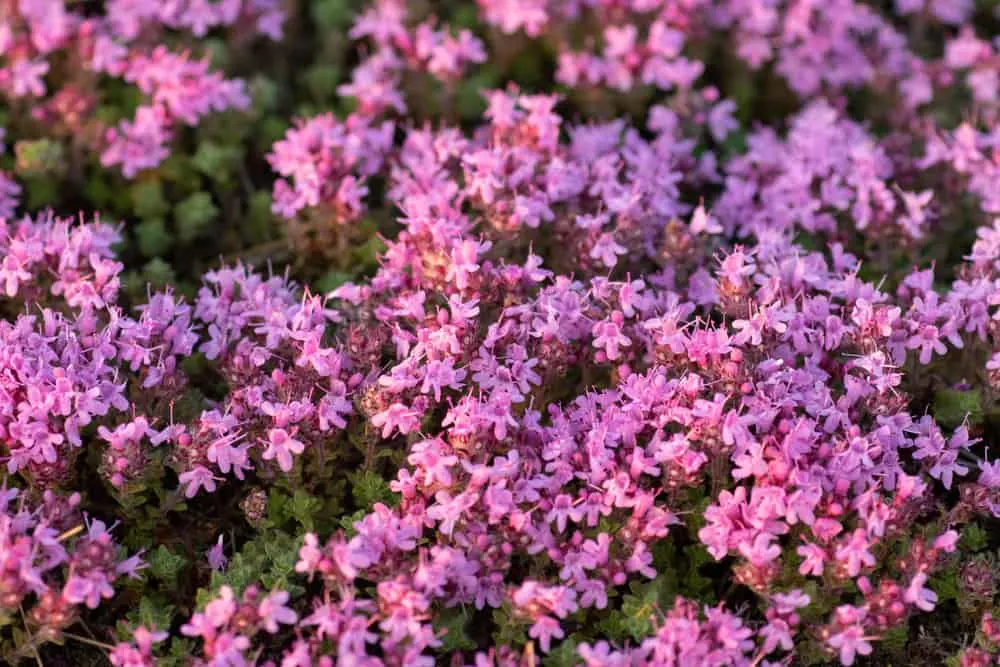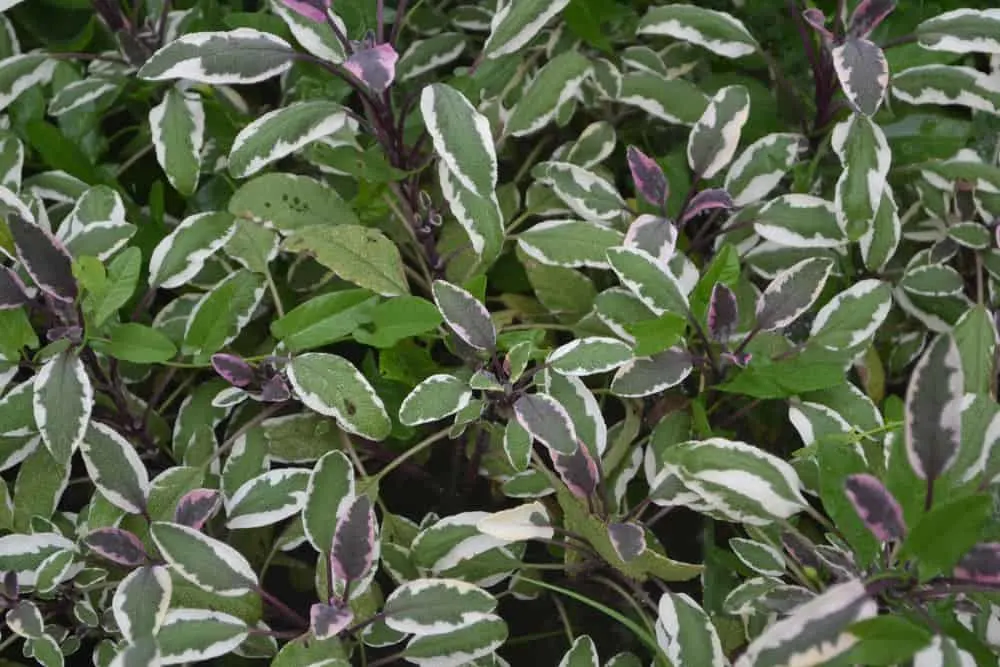
Whether you’re looking to line a pathway or finish a newly planted flower bed, border plants are the ideal solution to round off any garden design.
Tall or short, sprawling or compact, these plants create defined spaces in your garden that can make it look professionally planned, even if you’re a beginner.

Bordering with plants adds a splash of color, movement, and texture to garden beds, pathways, and any landscaped edging.
These 10 border plants are low maintenance, while still looking fantastic in any space. Some even have extra bonuses that’ll make having a living edge that much more worthwhile.
1. Wedgewood Blue

When thinking of lilacs, you wouldn’t typically consider them an edging plant. Plants in the Syringa genus often grow as tall as 10 feet.
However, nestled in this group of plants is the Wedgewood blue, a smaller variety that adds soft lavender hues to any border. It only grows to about 4 or 6 feet, a great option for narrow pathways lacking a statement piece.
This lilac variety has delicate pink buds that become stunning pastel purple blooms. They’ll stand out in any space, or go with similar soft blue-purple tones, painting a tranquil blue image.
Lilacs are relatively easy to care for, and this variety is no different. Wedgewood blues grow best in USDA zones 3-7 and thrive in full sun. They’ll appreciate at least six hours of sunlight a day. They may tolerate some shade, but you run the risk of limiting their bloom.
Wedgewood blues need a rich loamy soil that drains well to grow best. They can survive in part clay soils, but again, you run the risk of stunting their growth and limiting their blooms. Avoid oversoaking the soil too – lilacs are prone to root rot.
After planting, this shrub requires a few deep watering’s to get going. Once it’s established though, you’ll only need to sprinkle your Wedgewood blues more often in times of drought or excessive heat, as it prefers soil on the dry side.
Speaking of heat, lilacs don’t typically enjoy areas with hot and humid summers. They can handle freezing winter temperatures, needing some protection from biting winds, but pushing through to flower again the following season.
2. Lavender

While we’re on the lavender color train, let’s chat about the lavender plant.
Lavender is, without a doubt, a garden staple. This classic plant finishes any bed perfectly. Or, for an interesting touch along a pathway, plant a lavender hedge. Here’s why you should grow a lavender hedge and how to do it.
Lavender’s looks and smell catch everyone’s eye and attract some lovely garden visitors. You’ll be treated with bees and a variety of other beneficial insects, adding even more life to your garden.

Lavender is also on the top of a long list of plants that thrive in poor soil. They’re not fussy about much, making them incredibly low maintenance.
As an added bonus – its uses go beyond the garden. Make your own lavender essential oil from this stunning edging plant, or use it in the kitchen to make a calming tea.

This hardy perennial needs dry, well-draining soil to thrive. For longevity, neutral to alkaline soil is best, but not a necessity. And, as long as it’s got a full day’s sunlight, you’ll be treated with rich, purple-blue blooms come summer.
What makes lavender so great is its drought tolerance. (It’s one of our top picks for drought tolerant plants) Lavender is only slightly thirsty during its first growing season, so you’ll need to water them regularly. But, once they’ve established, water isn’t much of a concern.
With this in mind, you’ll need to pair them with plants that are just as drought tolerant. Yarrow is a great choice, along with a handful of Mediterranean herbs. Here’s our guide to the best lavender companion plants.
Lavender thrives in USDA zones 5-9, enjoying a wide range of temperatures. Lavender can typically withstand the cold and the heat, but doesn’t appreciate dampness caused by wet soil or high humidity. Ensure there is enough airflow and plenty of sunlight to keep damp from killing your lavender.
3. Alyssum

If you’re wanting to add some classic charm to your flower beds, then alyssums are the flowers for you.
Alyssum grows relatively quickly, but that’s not its only draw. Its soft, dainty flowers make an impact when grown in groups, brightening any border with its pink, white, and purple hues.
Alyssums only grow to about nine inches high, making them the perfect edging. They’ll add color without overshadowing any other flowers.
The only drawback is that aphids love them as much as we do. Be on the lookout for them and make sure you have your trusty water-spray bottle on hand. If you’re a fan of completely natural methods, you can simply introduce ladybugs to your garden. They’ll munch away any aphid infestation in a matter of days.

Alyssums are relatively easy to care for and don’t require much maintenance. This ground covering little plant loves full sun but will appreciate some shade in hotter, drier climates.
It thrives in warmer areas, growing best in USDA zones 5-9, but extreme heat won’t bode well. They’ll stop flowering in the height of summer, but come fall, they’ll brighten up your borders again.
When it comes to soil, alyssums require slightly moist but well-draining soil. They’re not too particular about the type, as long as their roots aren’t bogged down by water.
A thorough watering at least once a week will keep your alyssums thriving, increased during hot and dry spells.
4. Lady’s Mantle

Lady’s mantle is another ground covering plant, with delicate green-yellow blooms that soften structured edges. Their low height and inconspicuous flowers make great space fillers that add life without overshadowing the already bright blooms of other flowers.
This easy-going perennial loves the full sun, but it appreciates some afternoon shade in hot climates. Sun scorch is a point of concern when it comes to lady’s mantle. But, some shade and enough water should be enough to prevent sun damage.

Like most bedding plants, lady’s mantle doesn’t enjoy wet feet. Once established, it likely won’t need water more than once a week. If you’re concerned about heat, mulch around the base of the plant. This traps enough moisture without drowning the plant.
Lady’s mantle grows best in USDA zones 3-8, adapting to a variety of climates and temperatures. Humid climates may cause fungal problems, so ensure there is plenty of airflow between your plants.
5. Japanese Forest Grass

Clump-forming ornamental grasses are great choices for garden edging. An ideal option is Japanese forest grass, which stands out without being overbearing.
Its sharp blades spike out, adding some texture along your border. However, it’s the color of its leaves that is the real show stopper.
Japanese forest grass has gold leaves with deep green stripes running from tip to base. Even better, in mid to late summer, this little grass sprouts small flowers that show off in fall.
Japanese forest grass prefers part shade over full sun, so it’ll do wonderfully beneath taller plants that cast a shadow.
Some shade brings out the best in this ornamental grass, brightening its yellows and greens. Too much sun causes its tips to brown, while too much shade causes the green to take over, squashing all golden hues.
When it comes to care, Japanese forest grass needs rich, well-draining soil. Water this ornamental grass regularly, without drowning the roots. In hotter climates, lock in moisture by adding a layer of mulch around the base of the plant.
Japanese forest grass isn’t too fussy about where it’s grown, thriving in USDA zones 5-9.
6. Hosta

A classic garden border plant are hostas. This leafy favorite is a herbaceous perennial that thrives in a variety of conditions.
There are an endless variety of hostas to choose from in a range of colors, including the popular blue hostas. No matter which you pick, you’ll be sure to create an eye-catching border.

Hosta’s have unique leaves that draw the eye without dominating a space. In the warmer months, they sprout interesting flowers that attract an abundance of pollinators.

Hosta’s are relatively easy to care for, thriving in USDA zones 3-8. They’re not too phased about temperature, growing happily in most environments. They grow best in part shade but can thrive in full shade in particularly hot climates.
Hosta’s aren’t fussy about the kind of soil they’re in either, so long as it’s well-draining. Of course, if you’re wanting the best for this edging plant, it’ll appreciate rich, loamy soil.
When it comes to watering, a moist hosta is a happy hosta. Water at least once a week, and a little more in hot and dry climates.
7. Black Mondo Grass

If you’re looking for a simple yet outstanding edging plant, look no further. Black mondo grass has deep midnight blades that add contrast to any landscape. Its dark colors pair well with bright flowers (as long as they grow in the same conditions).
It grows to about 12 inches tall and wide, making it a perfect edging plant. You can make a statement with black mondo grass without overshadowing your greenery. Plus, it’s one of the few black-looking plants out there, bound to draw attention anywhere it is placed.

Black mondo grass is also rabbit and deer resistant for gardeners who have trouble with these adorable but pesky animals.
During summer, the black is broken up by small pink or white flowers. These bell-shaped flowers eventually fruit small, black berries (not edible ones, unfortunately).

Black mondo grass thrives in USDA Zones 6-9, enjoying the warmth and a variety of humidity levels. It isn’t a fan of high sunlight though, preferring part shade over full sun. To bring out the best in your black mondo grass, you’ll need to water it enough that the soil remains moist.
8. Creeping Thyme

Creeping thyme smells just as delicious as the herb to which it’s related. Its small flowers soften and brighten garden beds. Creeping thyme’s shortness and spread make it a great edging plant, or the perfect edible ground cover.
This herbaceous perennial grows to approximately 6 inches and can be as wide as 18 inches. Its flowers bloom in summer, sprucing up your flower beds without taking away from your main attractions.

For creeping thyme to thrive, it needs conditions similar to its place of origin, the Mediterranean (USDA zones 4-9). Warm days with full sun are the best for creeping thyme.
While loving the heat, thyme doesn’t enjoy high humidity. The best way to keep this plant airy is to prune it often. You’ll get rid of old dead foliage, while still keeping it bushy and attractive.
Watering is important for your creeping thyme while it’s still establishing itself in your garden. Once its roots have settled, it is relatively drought tolerant. Try to keep the roots moist but not soaked for your thyme to truly blossom and flourish.
9. Tricolor Sage

While we’ve got herbs on our minds, let’s talk about sage. Tricolor sage adds some spice to your garden and your kitchen with interesting leaves in (you guessed it) three colors – green with white or purple edging.
Tricolor sage shows off its color even more during the blooming season with small violet flowers. It’ll fit well into most flower beds, with purple tones complimenting a variety of colors and textures.
This stunning little herb is also relatively carefree too. It grows best in USDA zone 6-9, enjoying the full sun, but appreciating some shade in warmer areas. Much like creeping thyme, it needs a Mediterranean-like climate. Once established, tricolor sage is drought tolerant.
As a bonus – tricolor sage repels ants. If you have an ant problem in any of your beds, this plant is the perfect way to tackle it naturally.
10. Mophead Hydrangeas

We left a classic garden shrub for last, but it’s still among the best plants to use for borders. Mophead hydrangeas have many names – French hydrangeas, bigleaf hydrangeas, or pom-pom hydrangeas. They’re great tall border plants for pathways that bloom year after year.
Mophead hydrangeas are fun to care for too and make great gardening experiments. Their interesting flowers change color based on the pH of the soil. Blue flowers bloom from acidic soil, but if you plant your hydrangea in alkaline soil, you’ll get pink flowers.

They grow best in USDA zones 5-9. In cooler climates, hydrangeas need full sun to bloom reliably, but will appreciate some light shade in warmer areas.
While your hydrangeas are developing, they need plenty of water. But once they’ve established themselves, they’ll survive the occasional dry spell. In hotter climates, you may need to water more often, but don’t drench the soil.
Whether you need bright blooms or contrasting leaves, there is an edging plant for your garden border.
These ten make a statement on their own but also complete any space. When choosing border plants, always pick those with similar needs as the rest of the flower bed, and they will serve you well for years to come.
